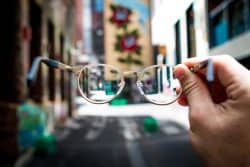Are you one of the 30 million Americans that wear contact lenses? These rigid or soft plastic lenses are a wildly popular alternative to glasses. They have been around since the late 1930’s and have become a favorite for people needing vision correction. However, while contact lenses are safely used by millions of people every day, they do carry a risk of eye infection, especially if they are not cared for properly. The single best way to avoid eye infections is to follow proper lens care guidelines as prescribed by your eye care professional. Here are some quick reminders of the best way to care for your contact lenses regardless of brand or style.
- Always wash your hands before touching contact lenses. Your hands carry bacteria that can not be seen but can easily be transmitted to the lenses when either putting them in or taking them out. Be sure to also dry your hands with a lint free towel.
- Remove contact lenses when going into water such as a pool or hot tub.
- Use saline solution or rub as your eye doctor discussed with you. Do not use spit or tap water. Saliva is not a sterile solution.
- Follow the specific contact lens cleaning and storage guidelines from your eye care professional and the solution manufacturer.
- This “rub and rinse” (rub your contact lenses with your fingers, then rinse the lenses with solution before soaking them) method is considered by some experts to be a superior method of cleaning, even if the solution you are using is a “no-rub” variety.
- Clean the lens case with fresh solution and let air dry.
- Do not re-use old solution even if you are trying to save money. This is a recipe for an eye infection that will cost you more in medication than the solution would cost.
- Keep the tip of the solution bottle away from any surfaces. Keep the top securely fastened.
- Wear and replace contact lenses according to the schedule prescribed by your eye care professional.
- Do not transfer contact lens solution into smaller travel-size containers. This can affect the sterility of the solution, which can lead to an eye infection.





